| Cell | Chlorophyll | Pigments | Membranes | Thylakoids | Storage | Covering | Flagella |
|---|---|---|---|---|---|---|---|
| Eukaryotic | a and b | None | 2 | 2-6 | starch | glycoprotein | 0-4 |

| Kalina Manoylov | Kalina Manoylov | Kalina Manoylov |
The Division Chlorophyta, or green algae, characteristically contain chlorophyll a and b and ß carotene.
Green algae are distinguished from other groups of algae by the types of chlorophyll molecules that they possess. Chlorophyll a and chlorophyll b are both molecules that absorb light energy in photosynthesis. Not surprisingly, the “green algae” are characteristically green in color. Green algae also contain ß carotene, another pigment molecule in addition to the chlorophylls. Like chlorophyll, ß carotene also functions in absorbing light energy from the sun. This group of algae stores the energy from photosynthesis within the cell, in the form of starch. This stored energy is also termed “carbohydrate reserve” and can be used to power cell processes when light is not available.
The chlorophytes live primarily in aquatic habitats. For example, most lakes, ponds, and puddles contain species of green algae. Members of this division also grow in salty waters of seas and oceans. Some species have very narrow range of conditions where they are able to live. “Snow algae” live on the surface of snowfields in the Rocky Mountains, and reach their greatest abundance in the summer, coloring the snow a rosy red. The patches of snow algae are called “red snow” or “watermelon snow”. Other chlorophytes live in desert soils or on rock surfaces. Like the other groups of algae, green algae are also important parts of aquatic ecosystems because they provide energy (food) to many larger organisms like zooplankton and fish.
Structure
The Division Chlorophyta is a diverse group with over 7,000 described species. Within this large group are cells that live individually as single cells, and those that form colonies of spherical balls, filaments, or other aggregations. Some colonies are attached to surfaces, like the surface of an aquatic plant and others float freely in the plankton. Some of the chlorophytes are able to move within water by using flagella. Some cells have four flagella, some have two, some cells lack flagella completely and some form beautiful colonies of flagellate cells.
Green algae in Rocky Mountain Lakes
In the Rocky Mountains, chlorophytes live in different aquatic environments. During the summer, snow algae live on the surface of snowfields. Chlorophytes also live on the rocks, soil, and within lichens, forming a symbiotic relationship with fungi. However, most of the chlorophytes live in mountain lakes, streams and ponds. Genera like Chlamydomonas, Chlorella, and Ankyra live in the planktonic habitat.
104 taxa shown below, 83 of which appear in at least one sample.
Region:
RMNP = Rocky Mountain National Park, CO
SLW = Silver Lakes Watershed, CO
Images are not scaled. An individual that looks bigger than its neighbors might actually be smaller. All images were made to fit within an area of 360px high and 200px wide.
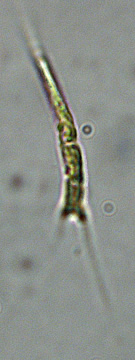 Ankyra sp. #1 Length 7-9 µm Width 2-4 µm |
 Ankyra sp. #2 Length 7-9 µm Width 2-4 µm |
 Chlamydomonas sp. #1 Length 6-8 µm Width 6-8 µm |
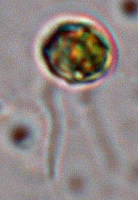 Chlamydomonas sp. #2 Length 3-5 µm Width 3-5 µm |
 Chlorella minutissima Length 3-5 µm Width 3-5 µm |
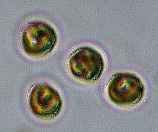 Chlorella sp. Length 1-2 µm Width 1-2 µm |
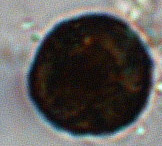 Chlorococcum sp. Length 8-10 µm Width 8-10 µm |
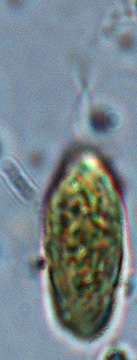 Monomastix sp. Length 5-10 µm Width 3-5 µm |
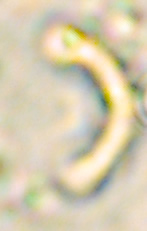 Raphidocelis microscopica Length 4-6 µm Width 4-6 µm |
 Scenedesmus ecornis Length 0.5-1.0 µm Width 0.25-0.50 µm |
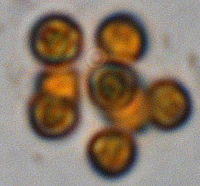 Sphaerocystis sp. Length 3-5 µm Width 3-5 µm |
Representative images missing for: Ankistrodesmus convolutus | Ankistrodesmus falcatus | Ankistrodesmus falcatus var. acicularis | Ankistrodesmus nannoselene | Ankyra judayi | Ankyra lanceolata | Chlamydomonas angulosa | Chlamydomonas dinobryon | Chlamydomonas sp. | Chlamydomonas sp. 1 | Chlamydomonas sp. 2 | Chlamydomonas sp. 3 | Chlamydomonas sp. 4 | Chlamydomonas sp. 5 | Chlorella ellipsoidea | Chlorococcum infusionum | Chlorogonium sp. | Choricystis (Coccomyxa) minor | Closterium gracile | Closterium sp. | Corone sp. | Cosmarium sp. | Cosmarium sp. 1 | Cosmarium sp. 2 | Desmidium sp. | Dictyosphaerium elegans | Dictyosphaerium sp. | Dictyosphaerium sp. 1 | Dictyosphaerium sp. 2 | Dictyosphaerium, spore of | Elakotothrix viridis | Eudorina elegans | Eudorina sp. | Eutetramorus didelta | Eutetramorus divaricatum | Eutetramorus fottii | Eutetramorus pulchellum | Gloeococcus sp. | Gloeococcus tetraspora | Gloeocystis sp. | Gloeocystis sp. 1 | Gloeocystis sp. 2 | Golenkinia radiata | Gonatozygon sp. | Gonium sociale | Gonium sp. | Gymnozyga moniliformis | Kirchneriella lunaris | Korshikoviella limnetica | Mesotaenium sp. | Micratinium sp. | Microspora sp. | Monoraphidium griffithii | Monoraphidium komarkovae | Monoraphidium sp. | Mougeotia sp. | Nephrocytium limneticum | Nephrocytium sp. | Octosporiella coloradensis | Oocystis gleocystiformis | Oocystis pusilla | Oocystis sp. | Pandoria morum | Pandorina smithii | Pandorina sp. | Pediastrum tetras | Phacotus lenticularis | Pleodorina californicum | Pteromonas sp. | Scenedesmus abundans | Scenedesmus aculeolatus | Scenedesmus quadricauda | Scenedesmus quadricauda var. maximum | Scenedesmus serratus | Scenedesmus sp. | Scenedesmus sp. 2 | Schroederia judayi | Schroederia setigera | Selenastrum minutum | Sphaerocystis schroeteri | Sphaerozosma sp. | Spirogyra sp. | Staurastrum radians | Staurastrum sp. | Staurodesmus (Arthrodesmus) incus | Synechococcus linearis | Tetraedron minimum | Treubaria sp. | Ulothrix sp. | unknown chlorophyte | Xanthidium armatum var. mediolaeve | Xanthidum sp. | Zoospores |

